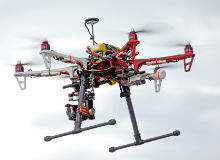

In March, Maersk Tankers revealed it had completed its first drone delivery to a ship, building on a wider programme to test whether unmanned aerial vehicles (UAVs) can be used and implemented in its supply chain. The package was dropped from a height of 5m above deck level.
Through this experiment, the company wanted to explore whether small drones are suitable for supplying vessels with spare parts, mail or medicine. In theory, it is an understandable path to take. Small, lightweight UAVs delivering small packages could remove the need for more conventional means of delivery, and Maersk sees it as way to cut costs.
One point to make is that the drone had to be launched from a tugboat as poor weather prevented take-off from shore, as originally planned. This highlights that while it simplifies one part of the process, it can, if conditions are unfavourable, add difficulty to another area.
The trend towards more autonomous operations continues, though, and the approach is already being used in shipyards. In September 2015 Poland’s Remontowa Shiprepair Yard inspected internal spaces of a ship remotely following an overhaul. By using a high definition camera, Remontowa was able to record video and take still images of one of the cargo tanks, looking at the condition of protective coatings and detecting corrosion and cracks.
Last June, the UK Royal Navy began trialling the use of drones to identify defects on HMS Diamond’s exteriors, reaching inaccessible area while at sea. Marcus Hember, HMS Diamond’s commanding officer, said it would “reduce time and cost during … maintenance periods, as well as allowing ships to diagnose their own defects at sea”.

US Tariffs are shifting - will you react or anticipate?
Don’t let policy changes catch you off guard. Stay proactive with real-time data and expert analysis.
By GlobalDataInspection, of course, also includes offshore installations and the safety benefits of using technology rather than humans for such tasks are evident. In the US, a quadrotor measuring 23in wide and 12in high was used to gather information relating to onboard fire-fighting on a former US Navy ship, navigating a smoke-filled area to map areas and locate fire, providing a clear safety benefit.
Surveillance and search and rescue
Speed and efficiency are important considerations in this context. If a drone can get to difficult-to-reach parts and identify the problem, it can be fixed more quickly. What these trials have in common is a belief that there is untapped potential for smaller drones and that it is not only large unmanned vessels that are part of the industry’s autonomous future.
Take the refugee crisis currently unfolding. The director of the European Maritime Safety Agency (EMSA), Markku Mylly, has said that drones could be used to monitor small boats in “so-called hotspots” to support search and rescue efforts.
In December the EU Commission recommended forming a European Border and Coast Guard which, in collaboration with the European Fisheries Control Agency and the EMSA, would be able to launch joint operations – using small aircraft – to gather information on vessels and cross-border crime.
Cracking down on crime is something the Port of Busan in South Korea has taken to, as well. The port authority announced last year it would use drones as part of its measures to prevent ships illegally anchoring in nearby sea lanes, using HD cameras for identification.
Hellenic Shipping News quoted an official as saying: “In cracking down on illegal vessels invading the sea lanes, we will expand the usage of the drones to check the condition of container stacks or the safety of anchored vessels in the port.”
Emission-sniffing drones
Deterrent measures are also coming into force in Istanbul, with the Metropolitan Municipality’s Marine Services Directorate declaring that drones will be used to monitor the Bosphorus for maritime pollution, taking photographs and video footage. Personnel are being trained and operations are expected to begin very shortly.
This follows on from a proposal by the EMSA and the European Space Agency to introduce ’emission-sniffing’ drones to clamp down on sulphur emissions, particularly in the English Channel, the North Sea, the Baltic Sea and the Gulf of Bothnia. According to a report in the Wall Street Journal (WSJ), these could be fitted with sulphur and carbon dioxide sensors and travel through the exhaust plume. The initial report was released in November 2015 and, following an experiment in the summer, operations could start by the end of the year.
With the Paris COP21 talks still fresh in the mind, applying drone technology for emission measurement and reduction is a wholly sensible idea. In fact, it is likely the most effective way of enforcing the EU’s sulphur directive, which limits emissions to 0.1%. “Member states are struggling to enforce the low-sulfur directives,” Leendert Bal, the EMSA’s head of operations, told the WSJ. “We need to do as much measuring as possible, and drones will help us do more measurements.”
Extending the reach and scope of what can be done is a big factor behind the expansion of drones, but legitimate concerns remain. What if a flight malfunctions and the aircraft is lost at sea or falls onto a ship? Also, could drones used for surveillance become too intrusive? Where do you draw the line? However, it is unlikely that these questions will cause a sudden change of heart for enthusiasts anytime soon.


